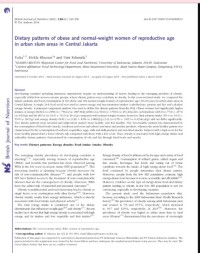Dietary patterns of obese and normal-weight women of reproductive age in urban slum areas in Central Jakarta

Developing countries including Indonesia imperatively require an understanding of factors leading to the emerging problem of obesity, especially within low socio-economic groups, whose dietary pattern may contribute to obesity. In this cross-sectional study, we compared the dietary patterns and food consumption of 103 obese and 104 normal-weight women of reproductive age (19–49 years) in urban slum areas in Central Jakarta. A single 24-h food recall was used to assess energy and macronutrient intakes (carbohydrate, protein and fat) and calculate energy density. A principal component analysis was used to define the dietary patterns from the FFQ. Obese women had significantly higher intakes of energy (8436·6 (SD 2358·1) v. 7504·4 (SD 1887·8) kJ (2016·4 (SD 563·6) v. 1793·6 (SD 451·2) kcal)), carbohydrate (263·9 (SD 77·0) v. 237·6 (SD 63·0) g) and fat (83·11 (SD 31·3) v. 70·2 (SD 26·1) g) compared with normal-weight women; however, their protein intake (59·4 (SD 19·1) v. 55·9 (SD 18·5) g) and energy density (8·911 (SD 2·30) v. 8·58 (SD 1·88) kJ/g (2·13 (SD 0·55) v. 2·05 (SD 0·45) kcal/g)) did not differ significantly. Two dietary patterns were revealed and subjectively named ‘more healthy’ and ‘less healthy’. The ‘less healthy’ pattern was characterised by the consumption of fried foods (snacks, soyabean and roots and tubers) and meat and poultry products, whereas the more healthy pattern was characterised by the consumption of seafood, vegetables, eggs, milk and milk products and non-fried snacks. Subjects with a high score for the more healthy pattern had a lower obesity risk compared with those with a low score. Thus, obesity is associated with high energy intake and unhealthy dietary patterns characterised by consumption of oils and fats through fried foods and snacks.
Detail Information
| Series Title | : | - |
| Call Number | : | - |
| Publisher | : | : British Journal of Nutrition., 2016 |
| Collation | : | British Journal of Nutrition (2016), 116(S1), S49–S56 |
| Language | : | English |
| ISBN/ISSN | : | - |
| Classification | : | NONE |
 Computer Science, Information & General Works
Computer Science, Information & General Works  Philosophy & Psychology
Philosophy & Psychology  Religion
Religion  Social Sciences
Social Sciences  Language
Language  Pure Science
Pure Science  Applied Sciences
Applied Sciences  Art & Recreation
Art & Recreation  Literature
Literature  History & Geography
History & Geography